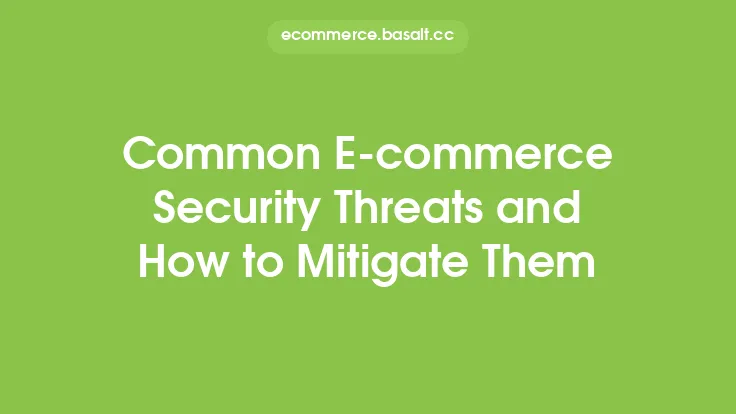As the e-commerce industry continues to grow and evolve, the risk of security threats and cyber attacks also increases. E-commerce businesses face a unique set of challenges when it comes to protecting their online stores, customer data, and financial transactions. In this article, we will explore the common e-commerce security threats, their risks, and provide guidance on how to mitigate them.
Introduction to E-commerce Security Threats
E-commerce security threats can be categorized into several types, including network threats, application threats, and physical threats. Network threats include attacks on the e-commerce website's infrastructure, such as denial-of-service (DoS) attacks, distributed denial-of-service (DDoS) attacks, and man-in-the-middle (MITM) attacks. Application threats include attacks on the e-commerce website's software, such as SQL injection attacks, cross-site scripting (XSS) attacks, and cross-site request forgery (CSRF) attacks. Physical threats include attacks on the e-commerce website's physical infrastructure, such as theft of equipment or unauthorized access to sensitive data.
Common E-commerce Security Threats
Some of the most common e-commerce security threats include:
- SQL Injection Attacks: These attacks involve injecting malicious code into a website's database to extract or modify sensitive data.
- Cross-Site Scripting (XSS) Attacks: These attacks involve injecting malicious code into a website to steal user data or take control of user sessions.
- Cross-Site Request Forgery (CSRF) Attacks: These attacks involve tricking users into performing unintended actions on a website.
- Denial-of-Service (DoS) Attacks: These attacks involve overwhelming a website with traffic to make it unavailable to users.
- Distributed Denial-of-Service (DDoS) Attacks: These attacks involve using multiple systems to overwhelm a website with traffic to make it unavailable to users.
- Man-in-the-Middle (MITM) Attacks: These attacks involve intercepting communication between a user and a website to steal sensitive data.
- Phishing Attacks: These attacks involve tricking users into revealing sensitive data, such as passwords or credit card numbers.
- Malware Attacks: These attacks involve using malicious software to steal sensitive data or take control of user systems.
Mitigating E-commerce Security Threats
To mitigate e-commerce security threats, businesses can take several steps, including:
- Implementing Secure Coding Practices: This includes using secure coding techniques, such as input validation and error handling, to prevent common web application vulnerabilities.
- Using Web Application Firewalls (WAFs): WAFs can help protect against common web application attacks, such as SQL injection and XSS attacks.
- Implementing Encryption: This includes using encryption protocols, such as HTTPS, to protect sensitive data in transit.
- Using Secure Password Storage: This includes using secure password storage techniques, such as hashing and salting, to protect user passwords.
- Implementing Access Control: This includes using access control techniques, such as role-based access control, to limit access to sensitive data and systems.
- Regularly Updating and Patching Software: This includes regularly updating and patching software to fix known vulnerabilities and prevent exploitation.
- Monitoring for Suspicious Activity: This includes monitoring for suspicious activity, such as unusual login attempts or large data transfers, to detect and respond to potential security threats.
Best Practices for E-commerce Security
In addition to mitigating specific security threats, e-commerce businesses can follow best practices to improve their overall security posture. These best practices include:
- Conducting Regular Security Audits: This includes conducting regular security audits to identify vulnerabilities and improve protection.
- Implementing Incident Response Plans: This includes implementing incident response plans to quickly respond to and contain security incidents.
- Providing Security Awareness Training: This includes providing security awareness training to employees to educate them on common security threats and best practices.
- Using Secure Payment Gateways: This includes using secure payment gateways to protect sensitive payment data.
- Complying with Industry Regulations: This includes complying with industry regulations, such as PCI DSS, to ensure the security and integrity of sensitive data.
Conclusion
E-commerce security threats are a growing concern for online businesses. By understanding the common risks and taking steps to mitigate them, businesses can protect their online stores, customer data, and financial transactions. By following best practices and implementing secure coding practices, using web application firewalls, implementing encryption, and regularly updating and patching software, businesses can improve their overall security posture and reduce the risk of security threats. Remember, e-commerce security is an ongoing process that requires continuous monitoring and improvement to stay ahead of emerging threats.





